
Desert trees enhance outdoor beauty with striking shapes and blooms while promoting sustainability through water conservation and local habitat support. We have the scoop on the top desert trees to make your yard a beautiful showstopper. Planting the Arizona desert trees is a perfect way to add sparkly shade, glitzy color, a beauty hint, and aesthetics to your yard without hassle or hard work.
In this blog post, we will discover the top popular desert trees in the Arizona landscape to take your yard to the next level! So, stay tuned until the end of this deserty post!
Why Choosing the Right Desert Trees is Key for Arizona Landscapes
Desert trees are superheroes for your yard! They help reduce heat, conserve water, and make your outdoor space look fantastic. You can enjoy your yard even in the hot Arizona sun with the right trees.
Benefits of Native Trees
Arizona’s severe climate is ideal for native trees. They require less water since they can withstand drought. This benefits the environment and saves you money.
Also, native trees attract wildlife like beautiful birds, butterflies, and more.
Balancing Looks and Function
When choosing desert trees, consider how they’ll look and work on your lawn. For this, you can consider the tree’s size, color, and growth rate. That, do you want a big tree for shade or a small one for a pop of color?.
Choose trees that fit your style and desires.
Sustainable Landscaping
The desert plants are an excellent option for environmentally friendly gardening. They save you money, improve the appearance of your yard, and benefit the environment.
You can design a stunning and ecologically responsible outdoor area that you can enjoy for many upcoming years by selecting the appropriate desert trees.
The Best Desert Trees in Arizona Landscaping
Folks! Let’s discuss the topmost desert trees in Arizona landscaping:
1. Desert Ironwood Tree (Olneya tesota)
Need a tree that’s as tough as the Arizona desert itself?.
Consider desert ironwood tree, then! The Ironwood tree is a unique plant from Arizona. It has tough wood. When fully grown, it’s 30 feet wide and 30 feet tall.
Key Features
- Iconic desert tree with a unique charm
- Stunning silver-gray foliage that adds beauty to your yard
- Possess pretty pink flowers that bloom in spring and fall
Benefits
- Extremely drought-tolerant, perfect for Arizona’s dry climate
- Supports local wildlife, providing a haven for birds and other desert creatures
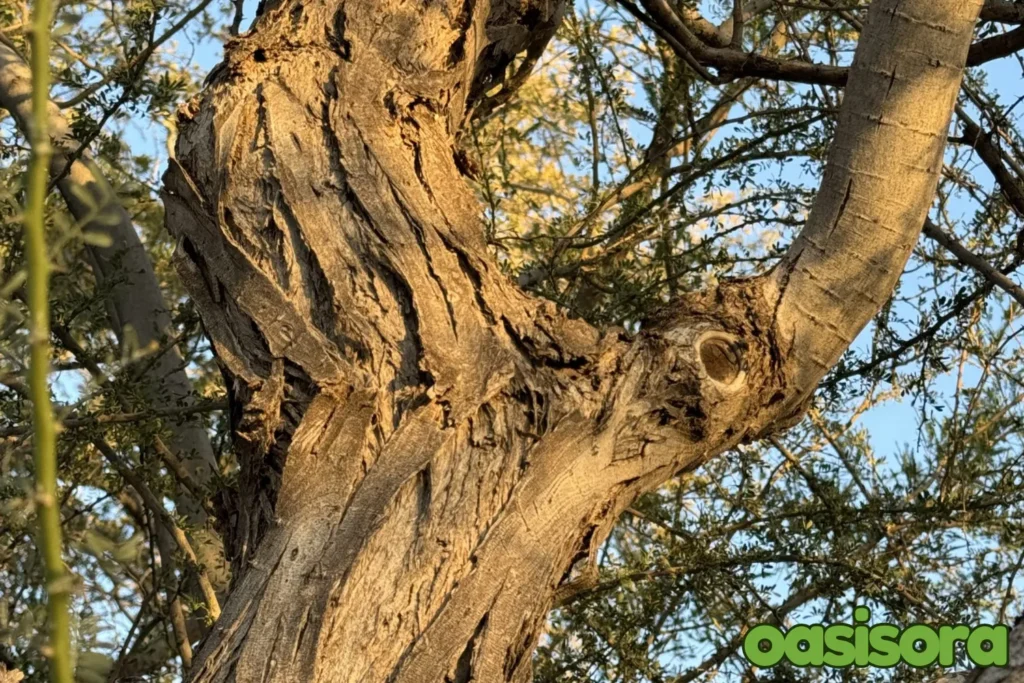
Ironwood tree
2. Desert-Willow Tree (Chilopsis linearis)
Native to the southwestern United States and northern Mexico, the desert-willow trees are stunning desert trees in the Arizona landscape.
Originally from the Southwest US and northern Mexico. It can grow up to 25 feet wide and 25 feet tall!
Key Features
- Small, deciduous tree with narrow, bright green leaves
- Willow-like foliage with a unique charm
- Fragrant flowers in beautiful lavender, pink, or white hues
- Unique, trumpet-shaped blooms that add a touch of elegance
Benefits
- Long blooming season that brings joy and color to your yard
- Attracts bees and hummingbirds, helping local animals.
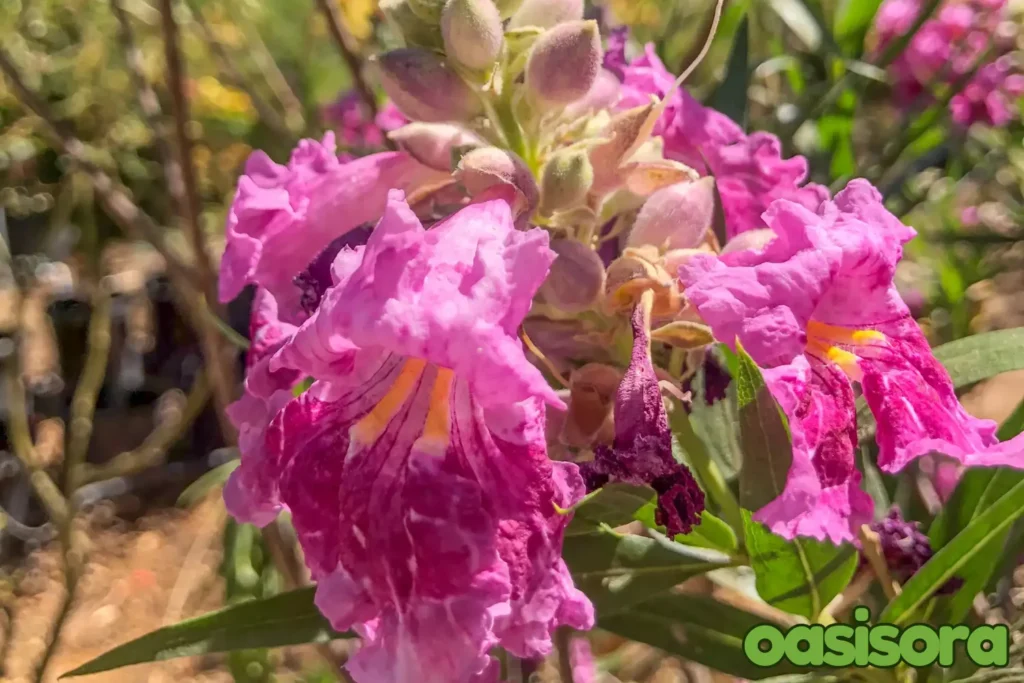
Desert willow (Chilopsis linearis)
3. Palo Brea Tree (Parkinsonia praecox)
The Palo Brea tree grows fast and gets really big – 30 feet wide and 30 feet tall! It’s originally from Mexico and some countries in South America.
It’s part of a special tree family called the palo verde trees.
Key Features
- Unique green bark that’s a sight to behold
- Delicate yellow blossoms that bloom in late spring
- Sculptural branches that add a touch of elegance
Benefits
- Provides filtered shade that’s perfect for hot desert days
- Grows quickly, so you can enjoy its beauty sooner
- Requires minimal care, making it perfect for busy gardeners

Palo Brea Tree (Parkinsonia praecox)
4. Texas Ebony Tree (Ebenopsis ebano)
Looking for shade desert trees in Arizona landscape that can thrive in a hot desert climate?.
Then, pick the Texas Ebony tree that stands at 30’ x 30’ when reaches its full maturity stage. Plus, they are excellent shade trees for Southern Arizona.
Key Features
- Dense evergreen canopy for year-round shade
- Fragrant flowers that bloom in late spring and fall
- Beautiful cream-colored flowers, dark green leaves, and dark brown seedpods
Benefits
- Compact growth, perfect for small yards and privacy
- Ideal for desert landscapes, with drought-tolerant and sun-loving qualities
- Can be planted in smaller spaces
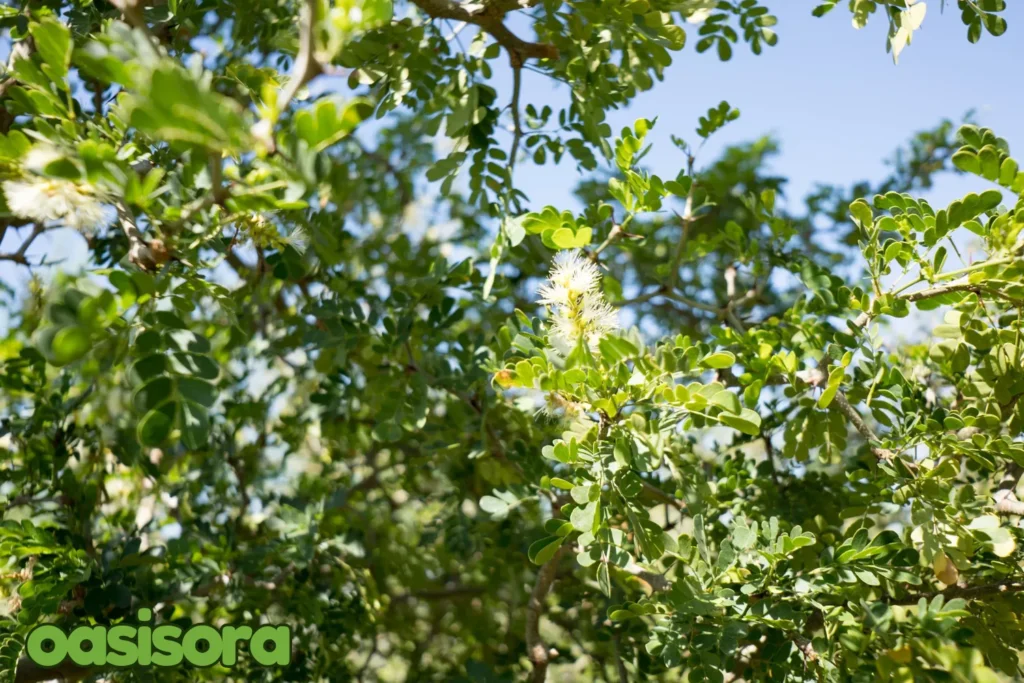
Texas Ebony Tree (Ebenopsis ebano)
5. Arizona Ash Tree (Fraxinus velutina)
The Arizona ash is a rapidly growing, deciduous tree that is native to California, Texas, Arizona, and Mexico. Interestingly, it’s a close cousin of the Oregon ash tree!.
Key Features
- Big tree that grows quickly and provides lots of shade.
- It has large, dark green leaves that feel tough.
- Bright yellow fall colors and white-green blooms add a touch of beauty to your yard.
Benefits
- Excellent for shade, perfect for hot desert days
- Thrives near water sources, making it ideal for landscapes with irrigation systems
- Such desert trees are ideal for residential landscapes

Arizona Ash Tree (Fraxinus velutina)
6. Texas Mountain Laurel Tree (Sophora secundiflora)
The Texas mountain laurel tree is a flawless prime plant choice if you are eyeing an attractive, low-maintenance tree for your Arizona patio!.
Native to Texas, this evergreen tree thrives in sunny plus dry environments.
Key Features
- Beautiful dark green leaves add a classy look.
- Bright purple flowers smell sweet like grapes.
Benefits
- Offers ornamental beauty perfect for aesthetic landscaping
- Low maintenance, making it ideal for busy gardeners
- This plant is great in dry places and doesn’t need much water.
Important Note: The Texas mountain laurel tree is pretty, but its flowers and seeds are poisonous. It’s not a good choice if you have pets or little kids.

Texas Mountain Laurel Tree (Sophora secundiflora)
7. Cascalote Tree (Caesalpinia cacalaco)
Need hardy desert plants that thrive in dry weather?
Try the Cascalote tree, it is an excellent choice! This beautiful tree is from Mexico and can handle the hot Arizona desert. It’s perfect for Arizona yards.
Key Features
- Have cheerful yellow flowers to add a pop of color
- Thornless varieties, making it a great choice for families
Benefits
- Thrives in full sun, perfect for sunny Arizona landscapes
- Compact size, ideal for smaller yards and patios
- Add a hint of lively tint to your garden

Cascalote Tree (Caesalpinia cacalaco)
8. Mesquite Tree (Prosopis spp.)
The Mesquite Tree is a strong and famous Southwest tree. It has pretty yellow flowers and can survive in the hot desert.
Plus, with their sprawling canopy and twisted trunk, such desert trees in Arizona’s landscaping look effortlessly excellent.
Key Features
- Hardy and fast-growing, with a unique airy foliage
- Native Arizonan, perfectly adapted to the local climate
Benefits
- Produces edible pods, a delicious and nutritious treat
- Provides ample shade, perfect for hot desert days
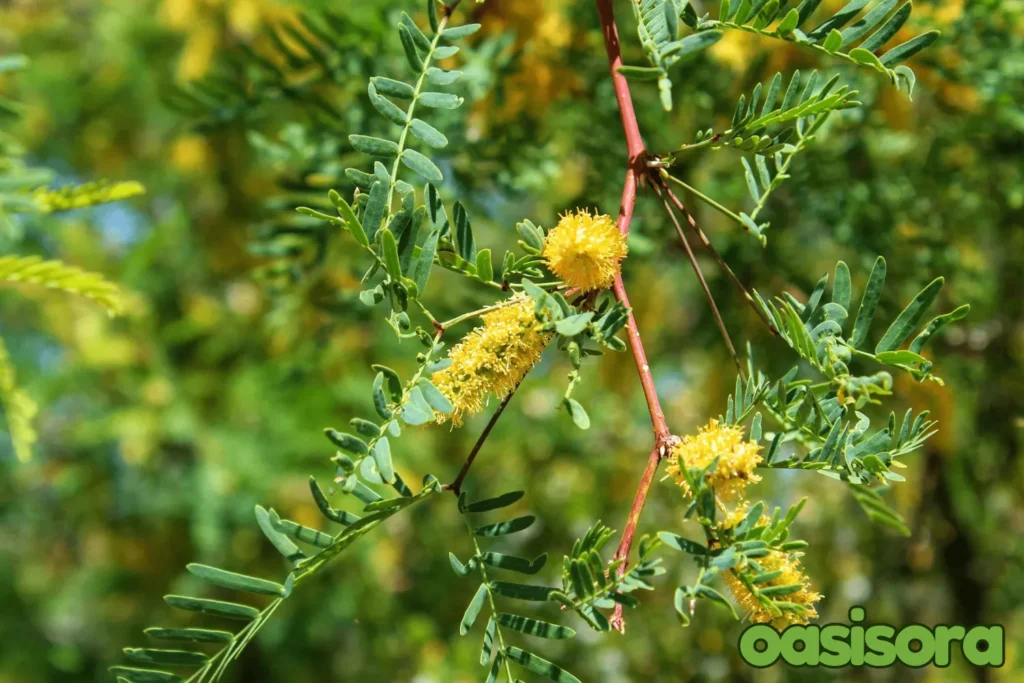
Mesquite Tree (Prosopis spp.)
9. Blue Palo Verde Tree (Parkinsonia florida)
The Blue Palo Verde Tree is a beautiful Arizona tree. It’s great at saving water and has bright yellow flowers and a unique blue-green trunk.
Key Features
- Arizona’s official state tree, a true desert treasure
- Unique blue-green bark and vibrant yellow blooms
Benefits
- Very drought-tolerant, great for saving water.
- Helps local animals like bees and birds.
- Adds a striking pop of color to any landscape
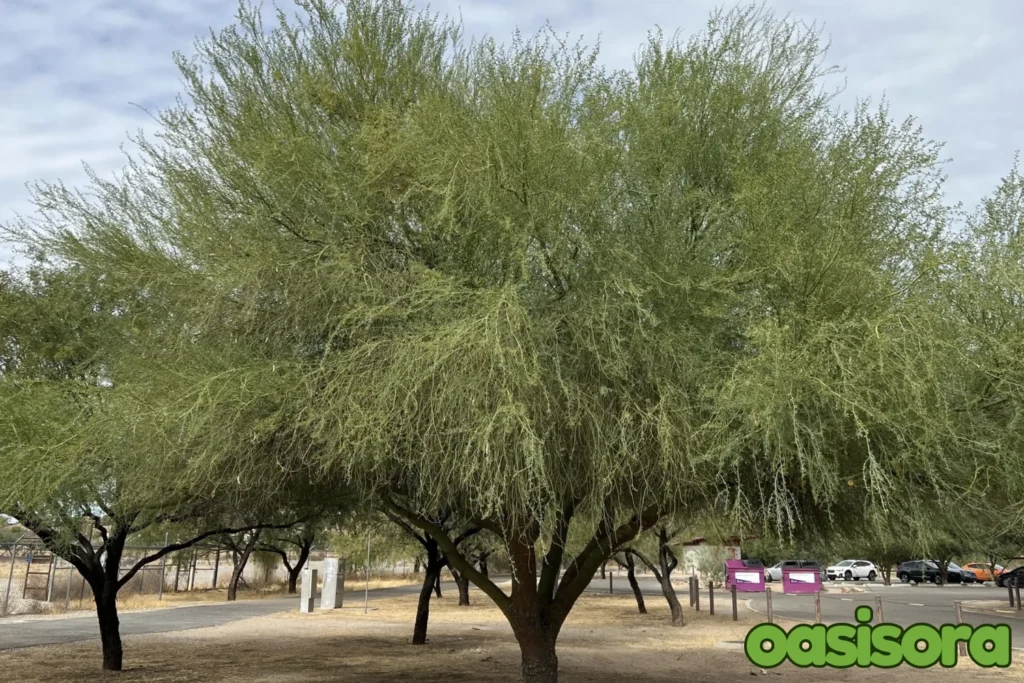
Blue Palo Verde Tree (Parkinsonia florida)
Additional Shade Trees for Arizona
Some other outstanding options for shade desert trees in Arizona include:
Chinese Elm (Ulmus parvifolia)
Do you need a versatile and fast-growing desert tree that delivers a broad canopy? If yes, then the Chinese Elm is excellent for you. It delivers shade and adds aesthetic beauty to your overall landscape:
Key Features
- Fast-growing- it grows rapidly to provide shade and beauty to your yard.
- Broad canopy- Offers ample shade and shelter from the sun.
- Adaptable- Thrives in a diversity of soil conditions.
Benefits
- Shade provision- Delivers shade and reduces heat in buildings.
- Aesthetic appeal- This desert tree adds natural beauty to your landscape.
- Low maintenance- Needs minimal care, making it really good for busy homeowners.
- Supports wildlife- Fascinates birds and other beneficial wildlife in your garden.
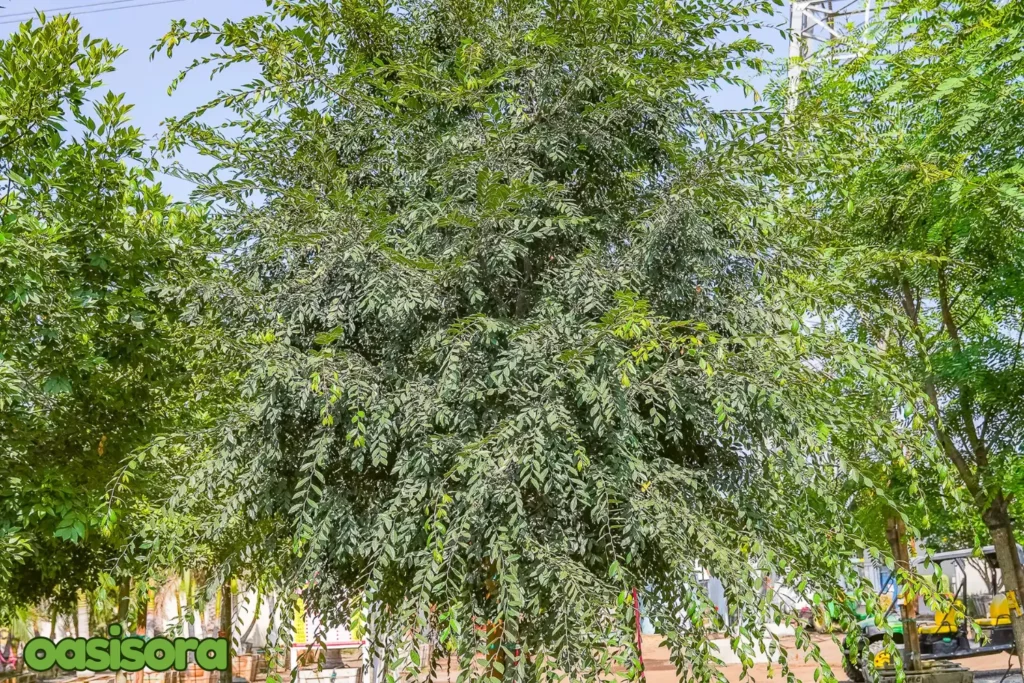
Chinese Elm
Chilean Mesquite (Prosopis chilensis)
The Chilean Mesquite is a tiny desert tree that grows up to approximately 12 meters tall. It have brown, cracked bark, and reddish type wood. Plus, its roots spread widely, and it has complex leaves with many leaflets.
Key Features
- Drought-tolerant- It can thrive in dry conditions with minimal watering.
- Wide canopy- Offers shade and shelter to the yard.
- Fragrant flowers- Attract perky bees and pollinators.
Benefits
- Shade- Reduces heat gain in buildings.
- Wildlife support- Attracts birds and pollinators.
- Low maintenance- Perfect for busy homeowners.
- Aesthetic appeal- Adds natural beauty.
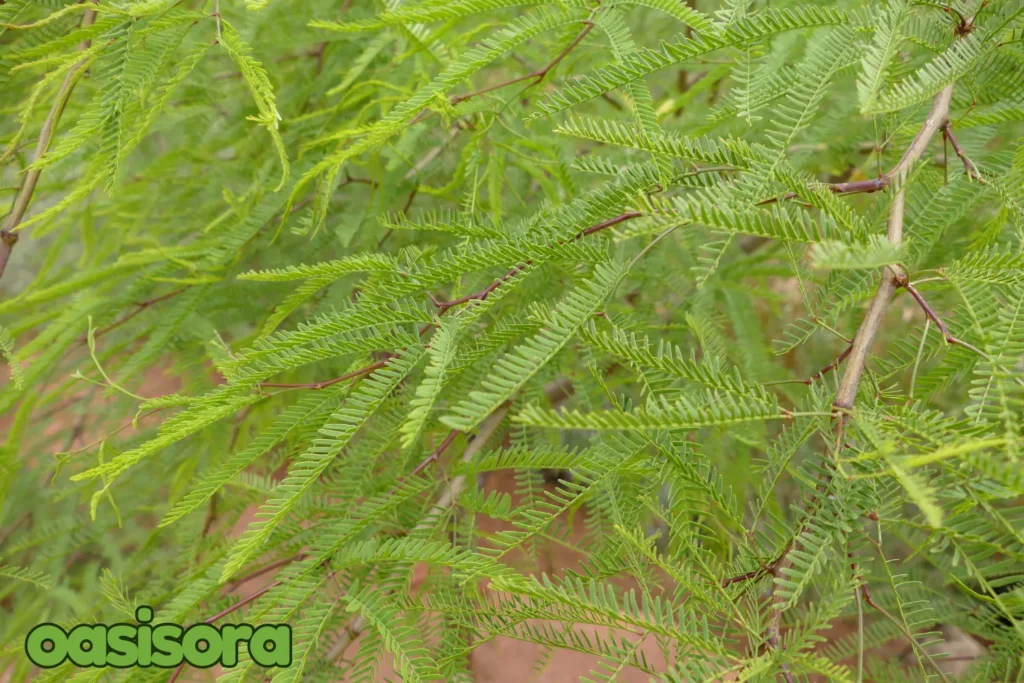
Chilean Mesquite
Velvet Mesquite (Prosopis velutina)
Another pick of desert trees in Arizona is the Velvet Mesquite. They are low-branching trees having dark and shaggy bark. It usually grows along washes and in foothills, has grayish-greenish leaves, and boasts many stems with thorns up to 3 inches long.
Key Features
- Fast-growing- It quickly grows to provide shade and beauty to your yard.
- Fragrant flowers- Crop lovely flowers that attract bees and other pollinators.
- Native tree- This tree is effortlessly adapted to the native climate and soil conditions.
Benefits
- Shade provision- Provides plenty of shade, perfect for hot desert days.
- Drought tolerance- Can thrive in dry conditions with minimal watering.
- Edible pods- Produces edible pods that can be used as a nutritious treat.
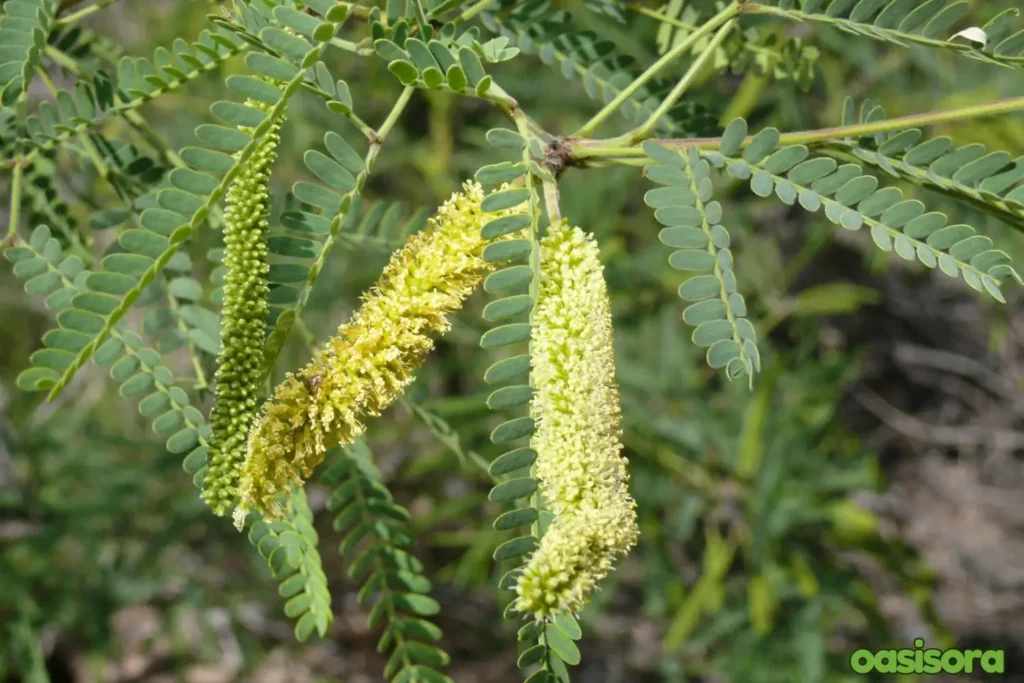
Velvet Mesquite
Fan Tex Ash (Fraxinus velutina ‘Fan Tex’)
The Fan-Tex Ash is one of the remarkable desert trees in Arizona having a majestic canopy and glossy, dark green foliage. It’s one of the adaptable and resilient desert trees that usually thrives in several soil kinds. Plus, the compact growth habit of it makes it really supreme for smaller landscapes and urban settings, too. The best thing about it is its leaves that turn to a pretty golden-yellow color in fall that looks effortlessly adorable.
Key Features
- Drought-tolerant- Needs less water, making it good for water-conscious landholders.
- Animated fall colors- With it, you can add a hint of tint to your landscape during the fall season.
- Shade provision- Offers ample shade and shelter from the sun.
Benefits
- Low maintenance- Requires less care, making it that’s perfect for busy homeowners.
- Aesthetic appeal- Adds natural beauty to your landscape with its vibrant fall colors.
- Supports wildlife- Attracts birds and other wildlife to your yard.
- Reduce heat – Reduces heat gain in buildings by offering shade.
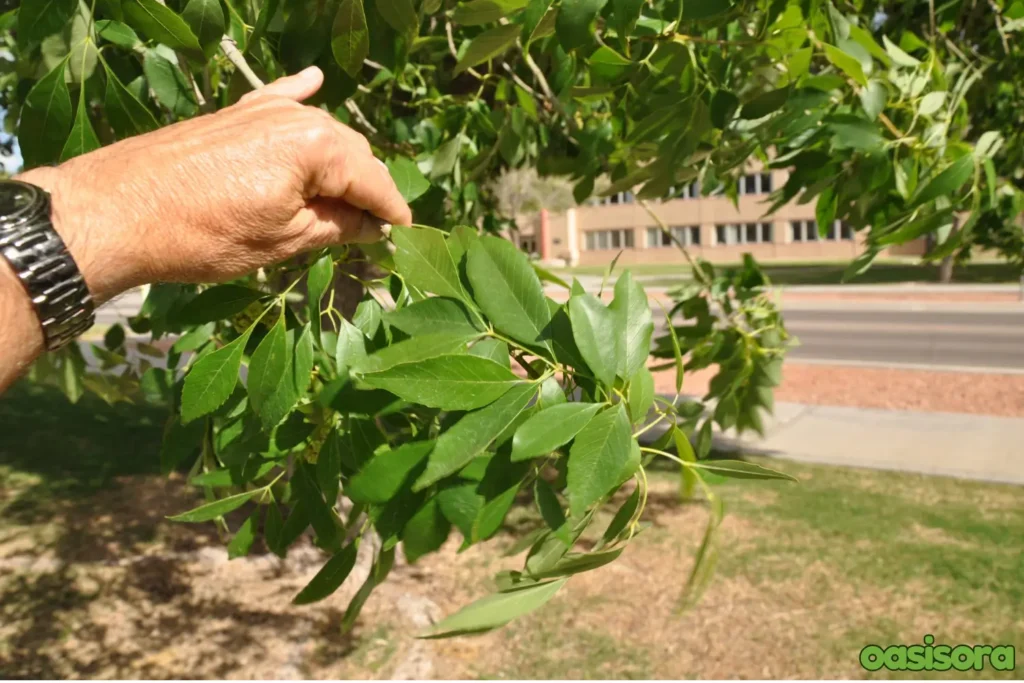
Fan Tex Ash
Mulga Acacia (Acacia aneura)
The Mulga tree is one of the tiny and adaptable desert trees in Arizona (also native to inland Australia). It has sufficient leaves and bright yellow flowers in tube-shaped spikes, with flat, rubbery pods. Acacia aneura is used to treat many issues, like:
- Skin Ailments
- Flu
- Coughs
- Colds
- Warts.
Key Features
- Slow-growing- Has a lazy growth, so it needs less maintenance and care.
- Feathery foliage- Adds a soft, mild texture to your landscape.
- Lively yellow flowers- With attractive bright flowers, it entices bees and other pollinators to your yard.
Benefits
- Aesthetic appeal- Enhance the natural appeal of your landscape with exciting flora.
- Supports wildlife- Charms pollinators to your yard that are beneficial for plants.
- Drought tolerance- Can thrive in dry conditions with minimal watering.
- Unique foliage- Boasts feathery foliage that adds unique texture to your site.
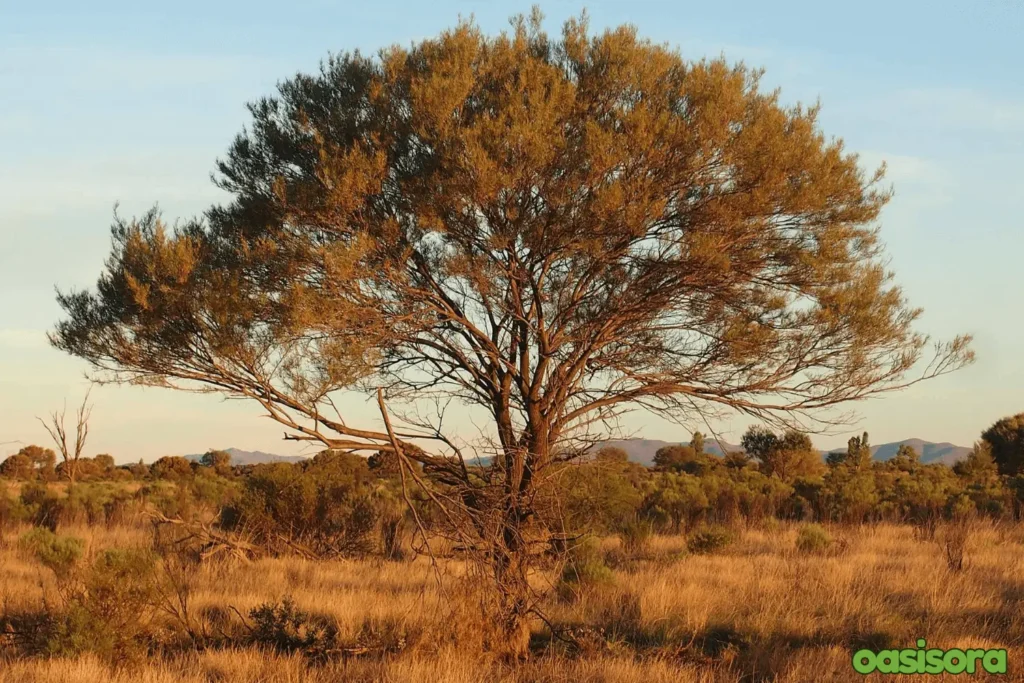
Mulga Acacia
Additional Tips for Designing with Desert Trees
Now, read these tips to design your desert trees in Arizona perfectly:
How to Combine Trees for a Balanced Landscape
Creating a balanced landscape is easy when you combine the right trees. Mix shade, ornamental, and accent trees to add depth and dimension.
- Shade trees like Palo Verdes and Mesquites provide relief from the sun
- Ornamental trees like Desert Willows and Texas Ebony add beauty and interest.
- Accent trees like Cascalotes and Blue Palo Verdes add color and texture.
- Where to Plant for Maximum Impact
Put trees in the right spots to block harsh sun and wind when planting. This makes your yard look good and work well. By picking the right trees and planting them correctly, you can make a beautiful and sustainable yard that you’ll enjoy for years.
Desert Tree Maintenance Guide
Now, folks, let’s dig in and explore the care essentials of desert trees in Arizona yard:
1. Watering and Irrigation
You should water the young trees frequently to establish their roots. Mature trees need less water but still require regular irrigation. Adjust schedules based on weather and soil conditions according to your region.
2. Pruning and Shaping
You should prune and shape your trees regularly to remove bad branches and keep them healthy. Moreover, pruning also enhances tree aesthetics and structure.
3. Pest and Disease Prevention
Inspect your desert trees in Arizona landscape regularly for signs of pests or disease. Look for yellowing leaves, white powdery residue, or tiny insects. Also, you should treat plagues promptly with organic or chemical solutions.
Final Thoughts
Designing an Arizona-Friendly Landscape
That’s all, my folks! With this guide, you can now create a beautiful Arizona desert yard that lasts!.
Choose the right desert trees in Arizona landscaping and enjoy many benefits. With these trees, you’ll have a pretty yard, cleaner air, and a higher home value.
Plus, with good planning, you’ll make a lovely outdoor space that’s easy to care for and brings peace and happiness to your home.
So, let Wildflower desert design guide you in selecting the perfect desert trees in Arizona for your dream landscape. Let’s grow a desert paradise together!.
FAQs
1. What kind of trees grow in the Arizona desert?
Palo Verdes, Mesquites, and Desert Willows thrive in Arizona’s desert. They’re adapted to the hot, dry conditions.
2. What is the best tree for Arizona heat?
Palo Verde trees are perfect desert trees in Arizona’s heat. They conserve water with deep roots and small leaves.
3. What is the best tree to plant in Arizona?
Desert Willow trees are stunning and thrive in Arizona. They’re low-maintenance and provide shade.
4. What is the least messy tree in Arizona?
Texas Ebony trees are tidy and low-mess. They have small leaves and compact growth.

1 thought on “9 Best Desert Trees for Arizona Landscapes in 2025”
Comments are closed.